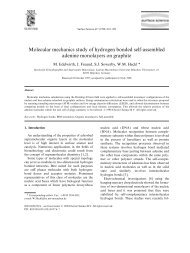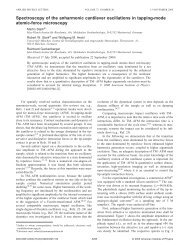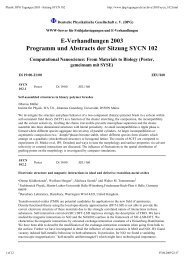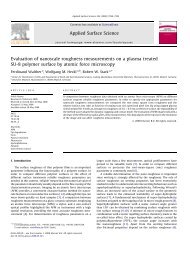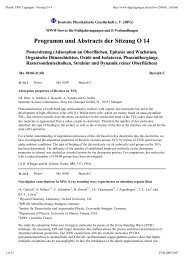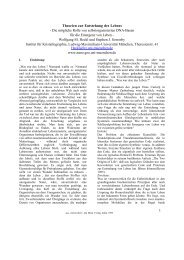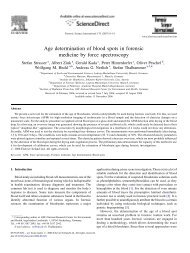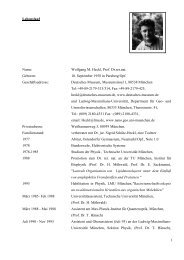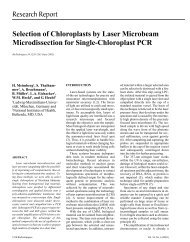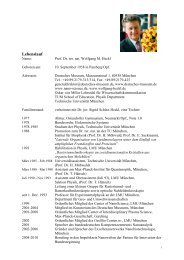Physik: DPG Tagungen - Sitzung O 28 - Nano-science.de
Physik: DPG Tagungen - Sitzung O 28 - Nano-science.de
Physik: DPG Tagungen - Sitzung O 28 - Nano-science.de
Create successful ePaper yourself
Turn your PDF publications into a flip-book with our unique Google optimized e-Paper software.
<strong>Physik</strong>: <strong>DPG</strong> <strong>Tagungen</strong> - <strong>Sitzung</strong> O <strong>28</strong><br />
http://www.dpg-tagungen.<strong>de</strong>/archive/2004/o_<strong>28</strong>.html<br />
•Stefan Andres, Wolfram Calvet, Tilo Plake und Christian Pettenkofer<br />
Hahn-Meitner-Institut Berlin, Glienicker Strasse 100, 14109 Berlin<br />
Zur Passivierung von Silizium-Substraten für die Heteroepitaxie sind III-VI terminierte Oberflächen von grossem<br />
Interesse. Wir präsentieren erste Ergebnisse dünner In- bzw. InSe-Schichten auf Si(111). Die Präparation <strong>de</strong>r<br />
Proben erfolgte mittels Molekularstrahlepitaxie (MBE) auf H-Si(111)1x1-, Si(111)7x7- und <strong>de</strong>finiert<br />
nasschemisch oxidierten Si(111)-Substraten. Die Schichten wur<strong>de</strong>n in situ mittels Photoelektronenspektroskopie<br />
(PES), nie<strong>de</strong>renergetischer Elektronenbeugung (LEED) und Rastertunnelmikroskopie (STM) bezüglich ihrer<br />
Morphologie und elektronischen Struktur analysiert. Es wur<strong>de</strong> zunächst <strong>de</strong>r Einfluss von elementarem Indium<br />
auf Si(111) untersucht. Im weiteren Prozess erfolgte durch sukzessives Koverdampfen von In und Se die<br />
Herstellung einer InSe-terminierten 1x1-Oberfläche. Es zeigt sich, dass InSe in einer sogenannten Halblage<br />
aufwächst, wobei die In-Atome direkt an die Si-Oberfläche gebun<strong>de</strong>n sind. Eine Selenisierung <strong>de</strong>r Si-Oberfläche<br />
fin<strong>de</strong>t nicht statt. Die Energetik <strong>de</strong>r Grenzfläche wird bezüglich Bandversatz und Grenzflächendipolen bestimmt.<br />
O <strong>28</strong>.30 Poster Mi 16:00 Bereich C<br />
Electrospray Deposition of Sensitive Analytes<br />
•Frank Stadler 1 , Sergei Koltsov 2 , Eugenio Lune<strong>de</strong>i 1 , Giovanni Costantini 1 und Klaus Kern 1<br />
1 Max-Planck-Institut für Festörperforschung, D-70569 Stuttgart<br />
2 Institute for Analytical Instrumentation, Russian Aca<strong>de</strong>my of Sciences, 19813 Saint Petersburg<br />
Electrospray ionization is well-known as a means to solve the volatilization and ionization problem of sensitive<br />
analytes such as large biomolecules [1]. Recently Ouyang et al. [2] reported that electrosprayed protein ions<br />
remain intact, after ionization, in vacuo transfer, mass-selection and soft landing. We present a novel<br />
electrospray <strong>de</strong>position source, whose objective is the non-<strong>de</strong>structive <strong>de</strong>position of large sensitive (e.g. organic<br />
and biological) analytes un<strong>de</strong>r UHV conditions. Aim of this project is to overcome the limitations of size and<br />
mass of the <strong>de</strong>posited sample material that are intrinsic to the organic molecular beam epitaxy techniques based<br />
on sublimation. Besi<strong>de</strong>s the explanation of the un<strong>de</strong>rlying working principle of this novel experimental setup, the<br />
relevant technological aspects will be discussed. In addition, AFM images of electrosprayed metal colloid- and<br />
protein-containing analyte solutions (<strong>de</strong>posited on highly oriented pyrolytic graphite) will be presented.<br />
[1] J. B. Fenn et al., Science, 246 (1989), 64-71<br />
[2] Z. Ouyang et al., Science, 301 (2003), 1351-1354<br />
O <strong>28</strong>.31 Poster Mi 16:00 Bereich C<br />
VUV photon <strong>de</strong>tector with improved resolution for inverse photoemission<br />
•R. Stiepel, R. Ostendorf, C. Benesch, H. Merz und H. Zacharias<br />
<strong>Physik</strong>alisches Institut, Universität Münster, D-48149 Münster, Germany<br />
We have significantly improved the energy resolution of a VUV isochromat spectrometer for inverse<br />
photoemission. The <strong>de</strong>tector used is a Geiger-Müller counter with acetone as filling gas and a CaF 2 entrance<br />
window. With this <strong>de</strong>tector we achieve an optical energy resolution of 330 meV (FWHM) at a mean energy of<br />
9.9 eV for the optical bandpass. With an additional gas absorption filter arranged between two CaF 2 windows at<br />
the entrance of the counting tube we enhance the resolution to 90 meV (FWHM) at a slightly <strong>de</strong>creased mean<br />
energy of 9.8 eV. The higher resolution <strong>de</strong>creases the counting rate to approximately 20%, but by filling or<br />
evacuating the gas chamber we can switch between the two mo<strong>de</strong>s high resolution and high counting rate<br />
within seconds.<br />
O <strong>28</strong>.32 Poster Mi 16:00 Bereich C<br />
Konventionelle und positroneninduzierte Auger-Elektronenspektroskopie am System Kupfer-Gold<br />
11 of 32 07.06.2009 22:14



